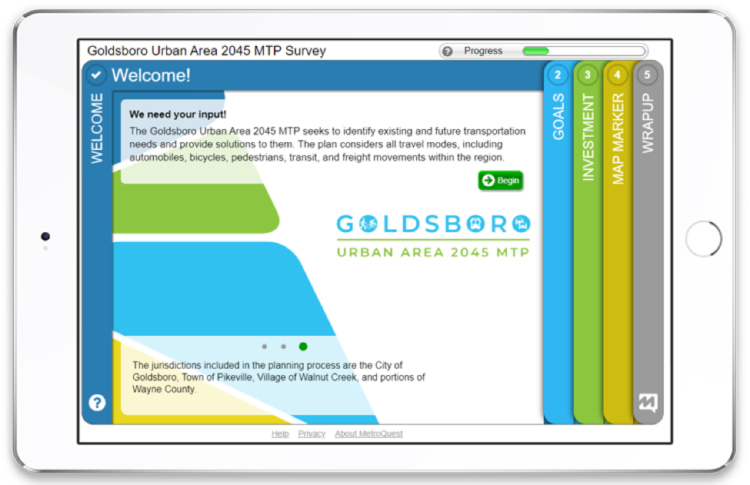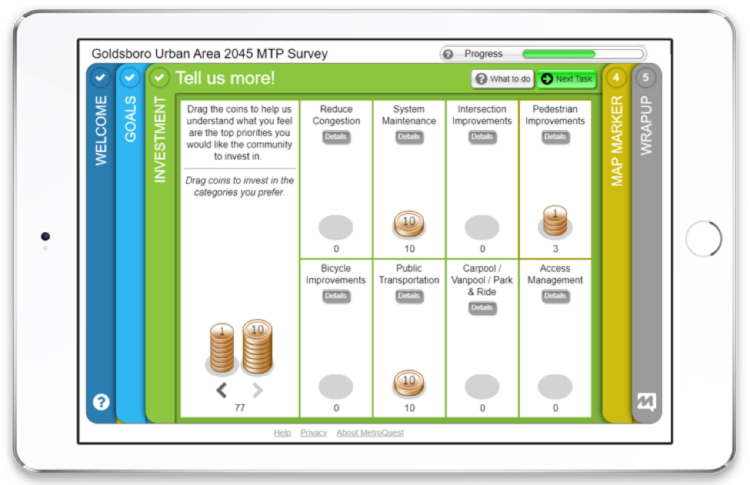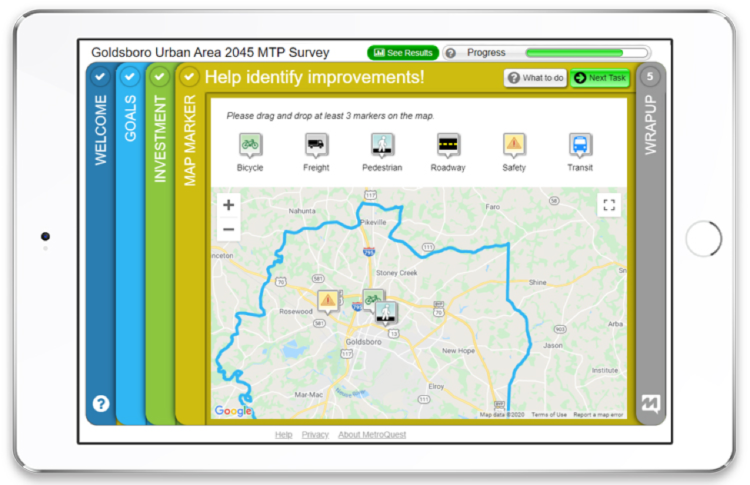[SURVEY OF THE MONTH] Compelling Online Public Engagement for a Metropolitan Transportation Plan Update Survey
![[SURVEY OF THE MONTH] Uncovering Future Transportation Needs with Reimagine I-10, TxDOT’s Corridor Feasibility Study [SURVEY OF THE MONTH] Uncovering Future Transportation Needs with Reimagine I-10, TxDOT’s Corridor Feasibility Study](https://metroquest.com/wp-content/uploads/Goldsboro_Survey_of_the_Month.png)
In June, we introduced the Survey of the Month blog: a particularly great example of a MetroQuest survey created by one of our users. We’re excited to share the take-aways to help with your next public engagement survey! While MetroQuest subscribers have no shortage of great public engagement surveys of all plans and project types, this month we’re showcasing a transportation survey to inspire your next MetroQuest survey!
We are excited to highlight a Metropolitan Transportation Plan (MTP) in North Carolina, for a Goldsboro Urban Area project under the subscription of the North Carolina Department of Transportation (NCDOT), in cooperation with Kimley-Horn. Read on to learn more about an exceptionally well-done MetroQuest survey for the ever-important purpose of transportation planning!
What’s the story? Updating Goldsboro’s 30-year plan to meet competing needs
The Goldsboro Urban Area 2045 MTP (Goldsboro MTP) was created to identify current and future transportation needs as well as solutions to address them. The plan is inclusive of all modes of transportation, including driving, biking, walking, transit, and freight movement, to guide multimodal improvements to the current network. The data generated by Goldsboro MTP’s community outreach campaigns will be used to update the previous plan, which was adopted in 2014.
Goldsboro MTP is a collaborative effort involving a Steering Committee, stakeholders, staff and elected officials, the NCDOT, as well as the Federal Highways Administration. Public input was gathered through the Committee, using both stakeholder interviews and workshops, as well as the MetroQuest survey. This allowed for input from residents of the City of Goldsboro, Village of Walnut Creek, Town of Pikeville, and Wayne County to understand regional feelings and concerns regarding transportation in the area. This feedback, along with stakeholder discussions and technical analysis, allowed the team to make a comprehensive multimodal plan that improved existing roadwork as well as meet growing demand for all types of multimodal facilities.
A full draft report from the project and its public outreach, including the MetroQuest survey, can be found here: http://www.goldsboronc.gov/wp-content/uploads/Goldsboro2045MTP_20190917.pdf.
Anatomy of an MTP Survey: How NCDOT Brilliantly Uses MetroQuest to Understand Residents’ Priorities
The Goldsboro MTP survey contains 3 main data collection activities: after introducing the project and providing background information, the first Screen provides a randomized list of eight possible goals, namely Maintenance, Accessibility, Environment, Security, Efficiency, Connectivity, Safety, and Economic Development, and the participant is asked to rank their top three in order of importance. This activity was designed to help set the direction of the multimodal transportation plan by understanding the residents’ top priorities. Safety was identified as the number one priority – in particular, facilities for bicyclists and pedestrians that make biking and walking safer were important to respondents.
On the second Screen, participants are presented with a stack of coins equaling an imaginary 100 dollars and are asked to distribute any or all coins into eight categories of projects: Reduce Congestion, System Maintenance, Intersection Improvements, Pedestrian Improvements, Bicycle Improvements, Public Transportation, Carpool/Vanpool/Park & Ride, and Access Management. This interactive gamification of a budget prioritization for the MTP not only helps to further define priorities, but also visually presents the reality that funds are limited and not all types of projects can be prioritized equally or at the same time. By gamifying the complexity of tradeoffs, the Goldsboro MTP Survey educates the participant and, therefore, collects more informed input. More on this later! Pedestrian Improvements was the category that the most hypothetical funds were allocated to.
To help identify improvements spatially, the next Screen asks participants to identify infrastructure needs by dragging markers to specific locations on a map and answering the corresponding drop-down questions. The marker topics are Bicycle, Freight, Pedestrian, Roadway, Safety, and Transit, and each follow up question asks the participant what is needed at the location, or to identify what the issue is. In typical fashion, the survey ends with a few demographic questions, which helps agencies and firms understand the demographic composition of the survey respondents, as well as a thank you message.
If you’d like to try the survey, click here: http://www.goldsboronc.gov/wp-content/uploads/Goldsboro2045MTP_20190917.pdf. This is a demo version that will not affect the survey results.
5 Tips from Goldsboro MTP: How to Make a Compelling Online Public Engagement Survey for Transportation Planning
The Goldsboro MTP survey makes the most of MetroQuest by combining data collection with education, leading to informed input and planning that supports community priorities. Below are 5 takeaways from their survey:
- Upon landing on the survey, the participant immediately sees the branding of the project, from the project logo colors used throughout the survey from the logo included in the background. It makes the project recognizable and ties in the survey as part of the MTP. Besides –a designer worked hard on the colors and logo to make it visually appealing, so why not take advantage of that?
- The Priority Ranking Screen is a great Screen to use for your first interactive activity as it provides a nice “warm-up” for participants and generates incredibly useful data on what is important to participants. To ensure it is a straight-forward activity, the survey spotlights priority items, in this case different MTP goals, using simple and concise language that is easy and quick to understand.
- Supporting each item on the Priority Ranking Screen with an image highlights the topic, provides additional context and clarification, and appeals to visual learners. However, it can be challenging to find the right images to enhance items, and they can visually clutter up the Screen. The team behind the Goldsboro MTP survey solved this beautifully by using icons that are easily understood and compliment the titles and descriptions seamlessly.
- The coin exercise is a great way to drill down on participant priorities in a fun and meaningful way. It allows participants to play with a fictional budget and understand limitations and tradeoffs. If your project has already allocated certain funds, this can be indicated with silver coins that cannot be moved. If coins are too close to real money for your liking, stars are also an option.
- The “Details” Pop Up in the coin game is used wisely in the Goldsboro MTP Survey to present examples of projects under each specific category. For example, under “Bicycle Improvements”, it states that placing coins into this category signifies an interest in investing in bicycle facilitation projects such as bike lanes and greenways. By providing more information and examples, participants are better equipped to make an informed decision, leading to more meaningful data without having to provide a level of specificity that does not typically exist at this phase of a project.
For more great tips on how to make the most out of MetroQuest, contact your Customer Experience manager or reach out for more information!
Want to learn more about how MetroQuest supports community outreach on your next transportation plan? Check out our recent webinar:
Brilliant Public Engagement by Women in Transit Planning
In this webinar, Adrienne Heim and Tracey Lin from the San Francisco Municipal Transportation Agency (SFMTA) show us exactly how they exceeded agency expectations by engaging 8,100 residents, collecting meaningful public input to build a data-driven transit extension study!




